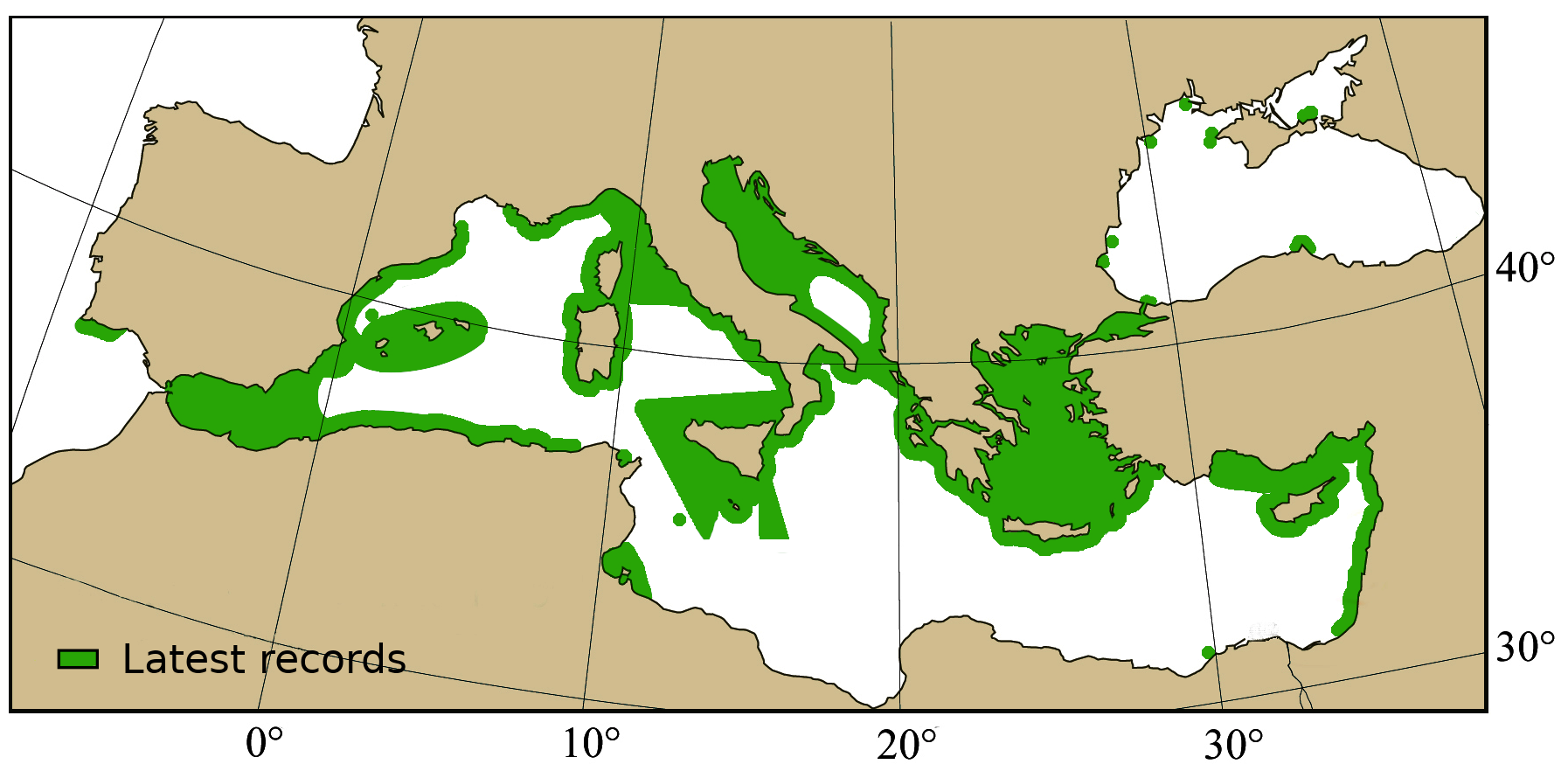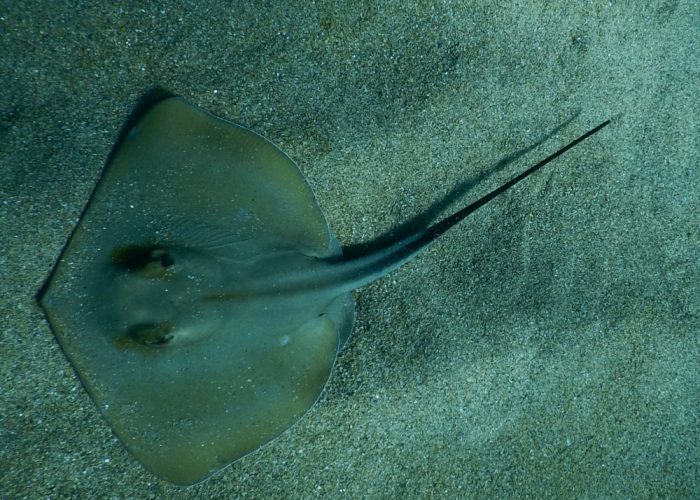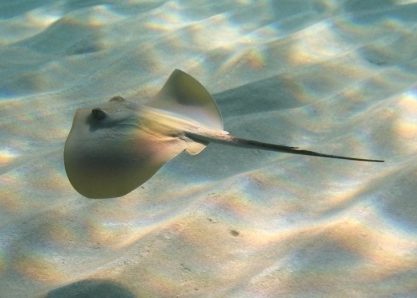Dasyatis pastinaca
Common name: Common stingray
Order: Myliobatiformes
Family: Dasyatidae
Synonyme: Trygon pastinaca
Misidentifications: Dasyatis tortonesei and Dasyatis marmorata
Short description
Small to medium sized species with a head flatter than body and prominent elongated snout. Rhomboidal disc, more or less sinuous margins, with a short membranous fold on the lower part. Long dorsal ‘keel’ under the dart. Teeth uniformly smooth. Spiracle length fits less than 1.2 times of prenarial length. Barbed poison spine is a modified denticle that can be 35 cm long, shed occasionally and replaced. Large bucklers only along the midline. The anterior extremity of the basibranchial is perforate.
Color: White ventral surface, with a large greyish-brown to blackish margin. Dorsal view is uniformly greyish green to brownish, varying to grey. Yellow coloration around eyes and orbits.
Measurements:
- Disk width (DW): 45 cm (max: 150 cm)
- Total length (TL): up to 250 cm
- Weight: up to 10.2 kg
Swimming pattern: Undulatory locomotion.
Biology / Ecology
Feeds on bottom fishes, crustaceans and mollusks.
Reproduction: Viviparous (aplacental viviparity with histotrophy). 4-7 juveniles per litter produced twice per year. Size at birth (DW): 12 cm. Maturity size (DW): 38-41 cm female, 30-32 cm male.
Habitat: Coastal benthic species in temperate water over sandy and muddy bottoms, sometimes near rocky reefs from shallow waters to 200 m of depth. Penetrates coastal lagoons, shallow bays and estuaries.
Unlike D. tortonesei, D. pastinaca has smooth tooth crowns.
Distinguishing characteristics
- Obtuse and short snout.
- Brown, olive or grey dorsal surface.
- Dart in the base of the tail.
- Large bucklers only along the midline.
- Yellowish colour around prominent orbits.
- Tooth crowns are smooth.
Myliobatiformes: No caudal and anal fin. Thin tail like a whip.
Dasyatidae: Batoids with depressed bodies.
Distribution
Worldwide: From the Northeastern of the French to Mauritania. Present in the Black Sea.
Mediterranean: Whole Mediterranean.
- Occurrence: Occasional but abundant in the central Mediterranean.
- Latest records: Scilla Bay – Italy (2023), Malta (2023), Cyprus (2018-2022), Central-North Aegean Sea (2019), Valencia coast – Spain (2017), Balearic Sea (2012-2015), Northern Ligurian and central Tyrrhenian Seas – Italy (2012-2015), Spain (2012-2015), Gulf of Gabes – Tunisia (2014), Rumelifeneri and Igmeada – Turkey (2014), Inceburun region – Turkey (2014), Marmara Sea (2013), Mersin bay – Turkey (2013), Corsica (2012), Iskenderun bay – Turkey (2011), Algeria (2010), Northern Turkey (2010), Gulf of Antalya, Izmir, Edremit & Sigacik bay – Turkey (2007-2009), Southern Tunisia (2009), Adriatic Sea (2008), Greece (2008), Saros bay – Turkey (2006), Alboran Sea (2004), Malta (2003), Syria (2001), Strait of Sicily (1991).

Any recent observation not on the map?
Contact us!
Conservation
Threats: Caught as bycatch by bottom trawlers and gillnet fisheries. Usually discarded. Wings are marketed smoked, dried-salted, and also used for fishmeal and oil.
Protection level:
- Europe: Vulnerable (IUCN 2015, last assessment: 2014)
- Mediterranean: Vulnerable (IUCN 2016, last assessment: 2016)
- Global: Vulnerable (IUCN 2021, last assessment: 2020)
Key references
- Agius A., Borg J. A., Schembri P. J. 2024. Batoid fishes associating with tuna farms in Malta. Rapp. Comm. int. Mer Médit. 43: 273.
- Carpentieri P., Nastasi A., Sessa M., Srour A. 2021. Incidental catch of vulnerable species in Mediterranean and Black Sea fisheries – A review. General Fisheries Commission for the Mediterranean. Studies and Reviews 101: I-317.
- Ferretti F., Myers R.A., Sartor P., Serena F. 2005. Long term dynamics of the chondrichthyan fish community in the upper Tyrrhenian Sea. ICES CM 25: 1-34.
- Ferretti F., Osio G.C., Jenkins C.J., Rosenberg A.A., Lotze H.K. 2013. Long-term change in a meso-predator community in response to prolonged and heterogeneous human impact. Scientific reports 3(1): 1-11.
- Follesa M. C., Marongiu M. F., Zupa W., Bellodi A., Cau A., Cannas R., Colloca F., Djurovic M., Isajlovic I., Jadaud A., Manfredi C., Mulas A., Peristeraki P., Porcu C., Ramirez-Amaro S., Salmerón Jiménez F., Serena F., Sion L., Thasitis I., Cau A., Carbonara P. 2019. Spatial variability of Chondrichthyes in the northern Mediterranean. Scientia Marina 83(S1): 81-100.
- Giovos I., Serena F., Katsada D., Anastasiadis A., Barash A., Charilaou C., Hall-Spencer J.M.,Crocetta F.,Kaminas A., Kletou D, Maximiadi M., Minasidis V., Moutopoulos D.K., Aga-Spyridopoulou R.N., Thasitis I., Kleitou P. 2021. Integrating literature, biodiversity databases, and citizen-science to reconstruct the checklist of Chondrichthyans in Cyprus (Eastern Mediterranean Sea). Fishes 6(3): 24.
- Grancagnolo D., Cattano C., Quattrochi F., Milazzo M. 2023. Preliminary evidence of a potential reproductive aggregation area of the common stingray Dasyatis pastinaca (Linnaeus, 1758)(Chondrichthyes–Dasyatidae) in the Central Mediterranean Sea. Mediterranean Marine Science 24(3): 639-643.
- O’Keefe M., Bengil EG., Palmer JL, Beton D, Çağlar Ç., Godley B.J, Özkan M., Snape R.T.E., Broderick A.C. 2023. Diversity and distribution of elasmobranchs in the coastal waters of Cyprus: using bycatch data to inform management and conservation. Front. Mar. Sci. 10: 1181437.
- Ordines F., Massutí E., Moranta J., Quetglas A., Guijarro B., Fliti K. 2011. Balearic Islands vs Algeria: two nearby western Mediterranean elasmobranch assemblages with different oceanographic scenarios and fishing histories. Scientia Marina 75(4): 707-717.
- Ramírez-Amaro S., Ordines F., Esteban A., García C., Guijarro B., Salmerón F., Terrasa B., Massutí E. 2020. The diversity of recent trends for chondrichthyans in the Mediterranean reflects fishing exploitation and a potential evolutionary pressure towards early maturation. Scientific Reports 10(1): 1-18.
- Saadaoui A., Saidi B., Elglid A., Seret B., Bradai M. 2016. Taxonomic observations on stingrays of the genus Dasyatis (Chondrichthyes: Dasyatidae) in the Gulf of Gabès (southeastern Mediterranean Sea). Zootaxa 4173(2): 101-113.
- Schembri T., Fergusson I.K., Schembri P.J. 2003. Revision of the records of sharks and rays species from the Maltese Islands (Chordata: Chondrichthyes). The Central Mediterranean Naturalist de Oceanología Academia de Ciencias de Cuba and Centro de Investigaciones de Quintana Roo, Mexico. 4(1): 71–104.
- Vella N., Vella A. 2021. Characterization and comparison of the complete mitochondrial genomes of two stingrays, Dasyatis pastinaca and Dasyatis tortonesei (Myliobatiformes: Dasyatidae) from the Mediterranean Sea. Molecular Biology Reports 48(1): 219-226.



